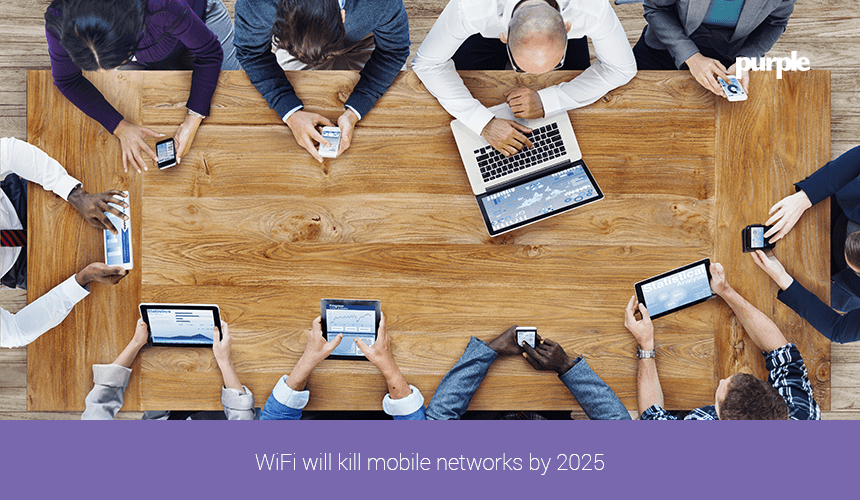We all want data, quickly and efficiently. From our FitBits to our Smart fridges, social media apps, and everything in between, we expect seamless connectivity. Businesses are equally as demanding – offices, hospitals, schools, airlines, hotels and restaurants and many other venues are consuming data at a rapid rate.
But how will our increasing demand for data affect the mobile networks? Could it result in their extinction? Purple CEO, Gavin Wheeldon, and Digitial Futurist Mike Ryan analyse data usage trends and forecast likely outcomes…
Mobile’s dependency on WiFi
The way we use our phones is changing. We don’t make calls or send texts, we use apps like WhatsApp to keep in touch with friends. We rely on our phones to entertain us and organize our lives, carrying out diverse tasks including banking, streaming TV and music, booking flights, dating, and controlling the central heating.
These changing consumer habits have already put enormous pressure on mobile networks and this will be exacerbated as unlimited plans become commonplace and when 5G arrives on the scene. Data usage will explode and the networks will be increasingly dependent on offloading data onto WiFi to keep up with demand.
Gavin Wheeldon says: “Although we may not be aware of it, much of our data consumption is handled by WiFi, rather than our mobile network. More traffic was offloaded from cellular networks on to WiFi than remained on them in 2016. As we enter the Zettabyte era, with annual global IP traffic expected to reach 3.3 ZB per year by 2021, it will be increasingly necessary for WiFi to take more of the strain.”
What does the future hold?
Mike Ryan, founder of Fusion Futures, says, “People in urban areas are already using WiFi on their mobile devices even when they think they are using 4G.
“In the next few years, wearable devices, such as digital contact lenses, will replace mobile phones and data usage will increase. WiFi, or an evolution of the current technology with unlimited speed (white noise communications AKA super-WiFi) will be the go-to-choice for data delivery, potentially removing 4G and 5G networks altogether by 2025.”
WiFi growth & evolution
By comparison, the future for WiFi looks robust, characterized by strong growth and continued technological advancements. By 2018, it’s predicted that there will be one WiFi hotspot on the planet for every eight humans. With an estimated CAGR (2015-2020) of 17.8%, the global WiFi market is expected to be worth $33.6 billion by 2020.
New figures from Purple show a similarly rosy picture, with the number of UK venues using its guest WiFi service increasing year-on-year (2016-2017) by 36%, while the number of unique users logging in to the WiFi at these venues is up by 57%.
“We are at a tipping point,” says Wheeldon, “If growth of WiFi continues at this rate, people in urban areas will soon be able to use fast, free WiFi exclusively for Internet access and data downloads.”
Sources:
Global Mobile Data Traffic Forecast Update, 2016–2021 White Paper, Cisco
